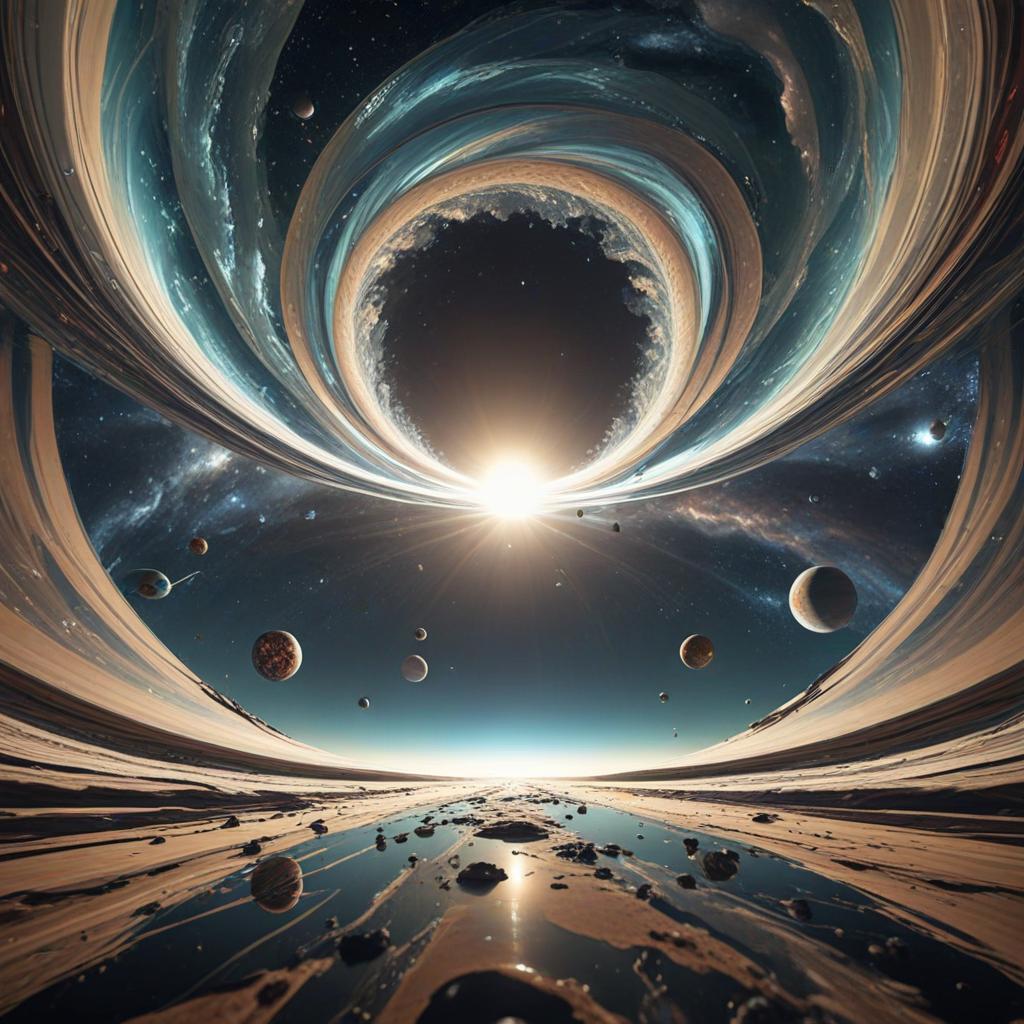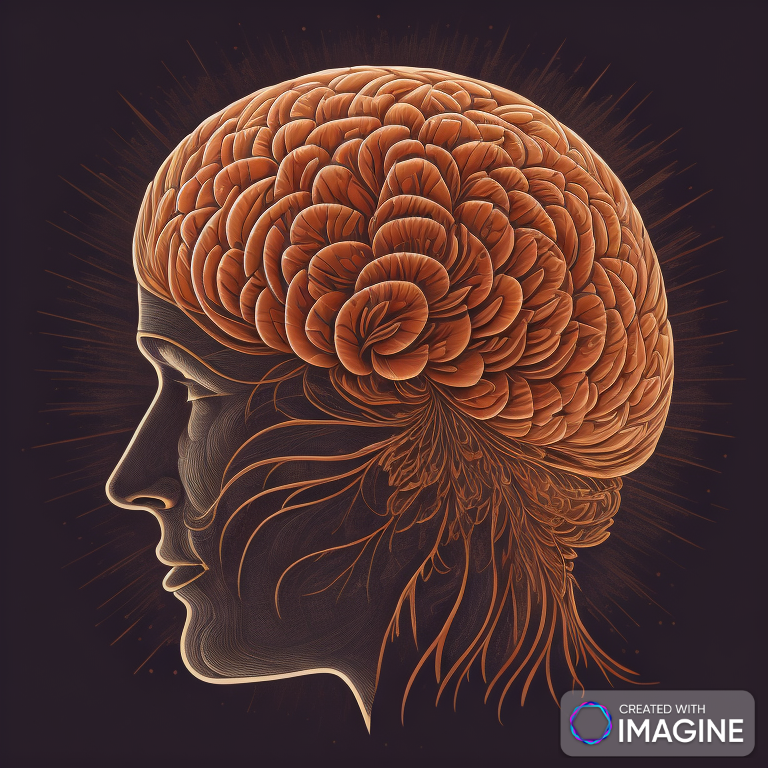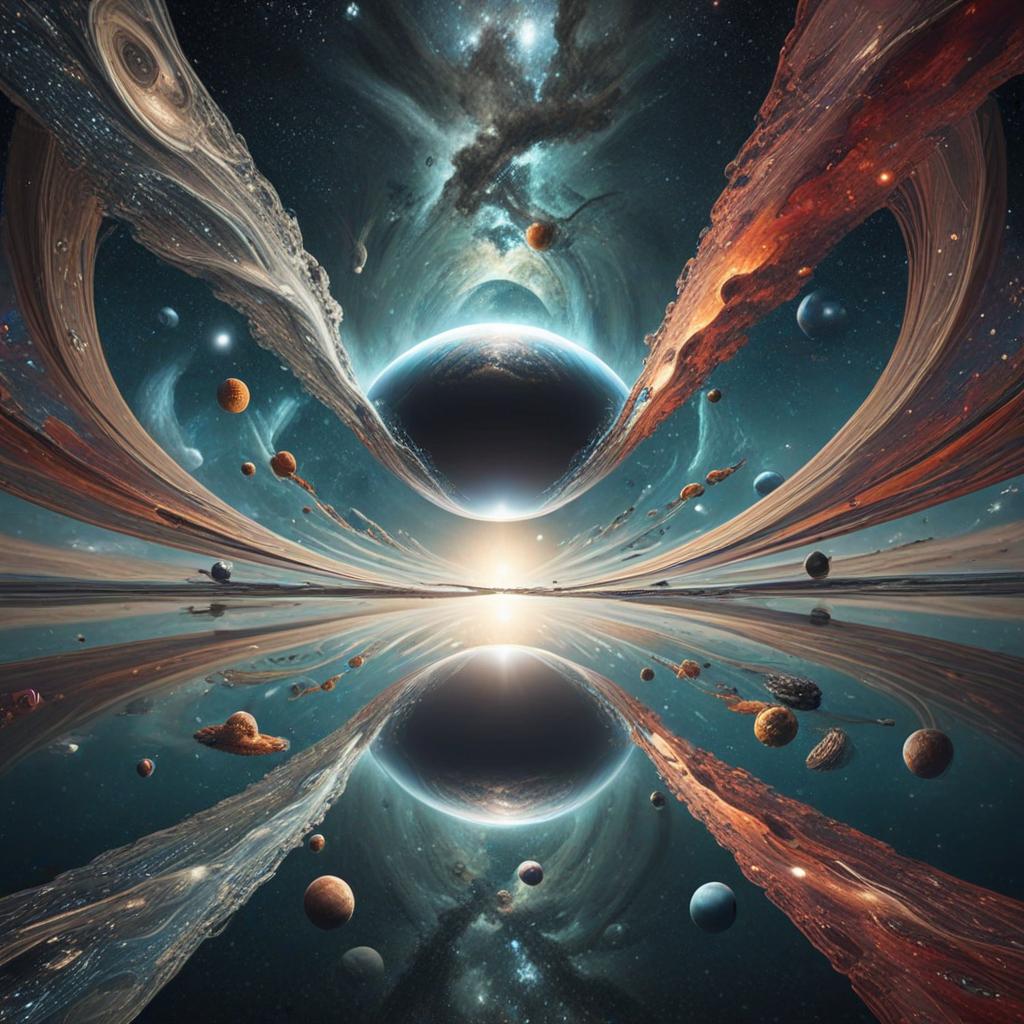Unraveling the Universe: How “Nothingness” Gives Rise to Everything
The idea that the rich complexity of the universe, including humans, animals, planets, and all forms of matter, can emerge from what appears to be “nothingness” is a profound concept in modern science. This mystery is explored in fields like quantum physics, cosmology, biology, and consciousness studies. By diving deeper into the forces of nature, quantum mechanics, the role of observation, and the uniqueness of human cognition, we can understand how this “nothingness” gives rise to everything.
Forces of Nature and the Emergence of Complexity
The forces of nature—gravity, electromagnetism, the strong nuclear force, and the weak nuclear force—are the fundamental interactions that govern the structure and behavior of all matter in the universe. These forces work on even the tiniest particles, guiding how they come together to form atoms, molecules, planets, and living organisms. Without these forces, the universe would remain in a state of unorganized energy and matter.
Even in the apparent “nothingness” of space, these forces shape the creation of stars, galaxies, and everything we observe. For example, gravity pulls matter together to form planets and stars, while electromagnetic forces shape the behavior of particles within atoms, enabling chemistry and eventually life.
Yet, this “nothingness” is not empty at all—it is filled with quantum fields, virtual particles, and the potential for creation. Quantum vacuum—the baseline energy state of space—contains fluctuations that can give rise to particles and fields, creating the foundation for all the objects, planets, and living beings we observe in the universe.
The Act of Observation: Bringing Reality into Existence
The role of observation in quantum mechanics is a strange but essential concept. According to quantum theory, particles exist in multiple states at once, described by a wave function. These particles do not have a definite position or state until they are observed or measured, a phenomenon known as wave function collapse.
This means that the act of observation plays a fundamental role in shaping reality itself. Without observation, particles remain in a state of probability, existing in many places or states at once. But once observed, the particle “chooses” a specific state, bringing it into reality.
While this principle primarily applies to subatomic particles, it raises deep philosophical questions about the role of consciousness and observation in the broader universe. Is the universe in some way dependent on observation to take form, or is observation simply a mechanism within an already existing universe?
Difference Between Humans and Animals: The Power of Thought
The ability to think and reason is what sets humans apart from other species on the planet. While many animals have complex behaviors, use tools, and can communicate, human cognition reaches far beyond basic survival.
- Cognitive Complexity: Humans possess advanced cognitive abilities, such as abstract thinking, problem-solving, self-reflection, and creativity. This allows us to not only interact with our environment but also to imagine and shape the future.
- Language and Communication: Human language is another critical difference. While animals communicate through signals, humans have developed language with syntax, grammar, and the ability to convey abstract concepts. This allows for sharing knowledge, culture, and innovation across generations.
- Consciousness and Self-Awareness: Human consciousness involves an awareness of self, a sense of identity, and the ability to experience emotions on a deeper level. The degree to which other animals experience these traits is debated, but humans appear to have a more advanced awareness of their own existence and mortality.
- Culture and Innovation: Humans have created culture, technology, art, and complex societal structures that allow us to manipulate the environment, share knowledge, and build upon the work of previous generations. This has resulted in everything from the development of civilization to the exploration of space.
The difference between humans and animals lies in the complexity and flexibility of human thought. While other species have evolved to adapt to their environments, humans have evolved to shape and manipulate their environment to suit their needs.
The Quantum Vacuum: The Source of All Creation
The quantum vacuum is the lowest energy state of a quantum field. Unlike a traditional concept of “empty space,” the quantum vacuum is teeming with virtual particles that pop in and out of existence due to quantum fluctuations. These fluctuations represent the constant ebb and flow of energy at a subatomic level.
In the quantum vacuum, particle-antiparticle pairs are spontaneously created and annihilated within extremely short time frames, which might seem like a fleeting phenomenon, but it holds profound implications for the origin of the universe.
- Quantum Fluctuations and Creation: Some theories, such as those related to cosmic inflation, suggest that the entire universe could have originated from a quantum fluctuation. In this sense, the quantum vacuum isn’t truly empty—it has the potential to give rise to entire universes, stars, planets, and even life.
- Casimir Effect: One striking piece of evidence for the quantum vacuum is the Casimir effect, where two uncharged metal plates placed very close together experience an attractive force due to quantum fluctuations between them. This is direct experimental evidence that the vacuum of space is not empty but filled with energetic potential.
- Higgs Field and Mass: Another example of how the quantum vacuum gives rise to the universe’s structure is the Higgs field, which permeates all of space. Particles that interact with the Higgs field acquire mass, allowing for the formation of matter. Without this interaction, particles would remain massless, and the universe would not be able to form complex structures like atoms and galaxies.
What Gives Rise to Objects, Humans, Planets, and Animals?
At the most fundamental level, everything in the universe—humans, objects, planets, and animals—arises from energy. Quantum fluctuations in the vacuum create particles, and these particles interact with the forces of nature to form atoms, which in turn form molecules, and eventually, all the larger structures we observe.
- Subatomic Particles to Atoms: Atoms are composed of subatomic particles—protons, neutrons, and electrons—which are themselves made up of even smaller particles called quarks and leptons. The forces between these particles, particularly the strong nuclear force, hold atomic nuclei together.
- Formation of Molecules: Atoms combine to form molecules through electromagnetic interactions, giving rise to the vast complexity of chemical compounds. Molecules are the building blocks of matter, forming everything from water and air to the complex proteins and DNA that make up living organisms.
- Stars and Planets: On a larger scale, gravity pulls clouds of gas and dust together, forming stars and planets. Stars are nuclear furnaces that create heavier elements like carbon and oxygen through nuclear fusion. When stars explode as supernovae, they scatter these elements across the universe, contributing to the formation of new stars, planets, and eventually life.
- Life and Evolution: Life on Earth emerged from the complex chemistry of molecules. The process of abiogenesis, the origin of life from non-living matter, is still not fully understood, but it likely involved the formation of self-replicating molecules like RNA. Over billions of years, these molecules evolved into more complex organisms through the process of natural selection. Eventually, this led to the rise of trillions of species, including humans, on Earth.
Why Humans Can Think So Much While There Are Trillions of Species on Earth
The human brain, despite its modest size, is exceptionally powerful. It has evolved to perform complex tasks like planning, problem-solving, and reasoning. What makes humans unique among the trillions of species on Earth is the cognitive capacity for abstract thought and self-awareness. While other animals have adapted to specific ecological niches, humans have evolved to adapt to an incredibly wide variety of environments, driven by the brain’s flexibility.
- Neural Complexity: The human brain contains around 86 billion neurons, each capable of forming thousands of connections, creating an intricate network that allows for higher-order thinking, memory, and creativity. This neural complexity gives rise to consciousness, imagination, and the ability to understand abstract concepts like time, space, and morality.
- Language and Symbolic Thought: The development of language gave humans the ability to communicate abstract ideas, share knowledge, and pass information across generations. This unique capability has allowed humans to build civilizations, develop technology, and reflect on the universe and our place in it.
- Culture and Learning: Unlike most other species, humans are deeply influenced by culture and learning. Our ability to accumulate knowledge, develop technology, and solve complex problems allows us to dominate the planet in ways no other species can.
The Nature of Nothingness: A Deeper Dive into the Universe’s Hidden Potential
When we speak of “nothingness” in the context of the universe, we must understand that it is far from a true void. Modern physics tells us that space, even when devoid of matter, is full of potential energy and virtual particles popping in and out of existence. This “nothingness” is brimming with energy and complexity, giving rise to the universe as we know it. Here, we delve deeper into concepts like quantum fields, vacuum fluctuations, the role of consciousness, and what truly differentiates humans from other species on a more advanced level.
The Quantum Field: The True Fabric of Reality
Beneath what we perceive as solid matter and empty space lies a fundamental structure known as quantum fields. Every particle in the universe can be thought of as a ripple or excitation in a corresponding quantum field.
- Fields as the Basis of Existence: Quantum fields fill all of space, and particles such as electrons or photons are just excitations within these fields. The quantum field, therefore, is the true “fabric” of reality, with particles emerging as localized manifestations of these fields. This idea blurs the lines between something and nothing. Even in a perfect vacuum, quantum fields are still present, and fluctuations in these fields can create particles out of what appears to be nothing.
- Vacuum Fluctuations and Particle Creation: These quantum fluctuations can have tangible consequences. For instance, virtual particles, which constantly form and annihilate within the quantum vacuum, are theorized to contribute to observable phenomena, such as the Casimir effect and Hawking radiation near black holes. This challenges the classical notion of a true vacuum and suggests that the potential for creation is ever-present, even in the most seemingly desolate regions of space.
The Role of Dark Energy and Dark Matter in Complexity
Our universe is not just composed of ordinary matter like stars, planets, and humans. In fact, about 95% of the universe is made up of dark energy and dark matter, both of which remain mysterious but are crucial to the universe’s structure.
- Dark Matter: While we can’t see or directly detect dark matter, we know it exists because of its gravitational effects on galaxies and clusters of galaxies. Dark matter provides the scaffolding for the universe, shaping galaxies and cosmic structures. It is what holds galaxies together, yet its exact nature remains unknown.
- Dark Energy: Even more mysterious is dark energy, which is responsible for the accelerating expansion of the universe. Despite being invisible and undetectable by ordinary means, dark energy represents a significant portion of the universe’s total energy. It is thought to exist in the vacuum of space, pushing galaxies apart. This suggests that even in “nothingness,” dark energy plays a crucial role in shaping the universe.
Together, dark matter and dark energy demonstrate that what we perceive as empty space is, in fact, far from nothing—it’s a bustling, dynamic realm filled with invisible forces that govern the universe’s evolution and complexity.
Consciousness and Reality: Is the Observer Fundamental?
A key philosophical and scientific question is whether reality itself is shaped by consciousness. The role of the observer is pivotal in quantum mechanics, where the act of measuring or observing causes a wave function collapse—the point at which particles “choose” a definite state.
- Consciousness as a Shaper of Reality: Some interpretations of quantum theory suggest that consciousness may play a fundamental role in bringing the universe into existence. The act of observation might collapse probabilities into tangible realities, implying that conscious beings, particularly humans, may have a direct influence on the fabric of reality itself. This has led to philosophical debates about whether consciousness is an emergent property of the brain or a fundamental aspect of the universe, akin to space, time, and energy.
- Does Reality Exist Without an Observer?: There’s an ongoing debate about whether reality exists independently of observation. In the Copenhagen interpretation of quantum mechanics, particles remain in a superposition of multiple states until they are observed. However, this raises a profound question: what happens in regions of the universe where there are no observers? Could entire aspects of reality remain in limbo until they are observed?
While the idea that observation creates reality is still contested, it forces us to question the relationship between consciousness and the universe. If consciousness plays an active role in shaping reality, it could fundamentally alter our understanding of existence itself.
Emergence of Objects and Life: From Particles to Planets and Humans
The process by which the universe moves from the “nothingness” of quantum fields to the vast complexity we observe—planets, trees, humans, and animals—is a cascade of creation that involves several stages of increasing complexity.
- Nucleosynthesis and Element Formation: In the aftermath of the Big Bang, only the lightest elements—hydrogen and helium—were formed. But the heavier elements that make up planets, trees, and human bodies were forged in the hearts of stars through nuclear fusion. As stars live and die, they disperse these elements into the universe, enabling the formation of planets and, eventually, life itself. Every atom in your body was created in the core of a long-dead star, highlighting the deep connection between life and the cosmos.
- The Role of Molecular Complexity: Life arises from chemistry, particularly the complexity of organic molecules. Carbon, which can form stable bonds with other atoms in an almost infinite variety of ways, forms the basis of all known life. Molecules like proteins, lipids, and nucleic acids (DNA/RNA) are the building blocks of living organisms. The spontaneous organization of these molecules into self-replicating systems marks the transition from non-living matter to life.
- The Emergence of Life: While we don’t fully understand how life emerged from non-living matter, current theories suggest that life began with simple molecules that gradually became more complex through chemical reactions driven by energy sources such as the sun or volcanic activity. Over billions of years, these simple molecules formed more complex structures, leading to the first living cells and, through evolution, the diversity of life on Earth.
- From Cells to Consciousness: Once life began, evolution through natural selection led to the development of more complex organisms. Multicellular life forms, nervous systems, and eventually brains evolved over millions of years. In humans, the brain became highly developed, leading to the emergence of consciousness—the ability to think, reason, and reflect on one’s own existence. This evolution of consciousness is unique to humans, and no other species on Earth exhibits the same level of self-awareness and cognitive complexity.
Human Cognitive Superiority: Why Can Humans Think So Much?
While there are trillions of species on Earth, humans are unique in their ability to think abstractly, reason, and reflect on the nature of the universe. Several factors contribute to this:
- Neocortex Development: The neocortex, a part of the brain that governs higher-order thinking, is disproportionately larger in humans than in any other species. This region is responsible for complex reasoning, planning, and problem-solving. It allows humans to not only survive but also to create art, develop technology, and engage in scientific inquiry.
- Abstract Thought and Imagination: Humans have the ability to think about concepts that don’t directly relate to immediate survival, such as time, space, and metaphysical ideas. This ability to engage in abstract thought enables humans to imagine different futures, hypothesize, and even contemplate the origins of the universe.
- Cultural Evolution: Unlike other species, humans have developed complex cultures that allow the accumulation and transfer of knowledge across generations. This has led to rapid advancements in technology, medicine, and science, accelerating our ability to understand and manipulate the world around us.
- Self-Reflection and Metacognition: Humans possess metacognition, the ability to think about their own thoughts. This self-awareness allows for introspection and personal growth, setting humans apart from other animals. While some animals show signs of self-awareness (like recognizing themselves in a mirror), human self-awareness is far more complex, involving not only recognition but also deep emotional and existential contemplation.
Quantum Vacuum and the Seeds of Creation
The quantum vacuum may hold the ultimate answers to how the universe—and everything in it—came into existence. Far from being an empty void, it is the ground state of all quantum fields, filled with fluctuating energy that can give rise to particles and, by extension, everything we observe in the universe.
- Vacuum Energy: The quantum vacuum contains a tiny amount of energy, known as vacuum energy, which could be the driving force behind the expansion of the universe. Some scientists hypothesize that the cosmological constant, a term in Einstein’s equations of general relativity, may represent the energy of the vacuum and is responsible for the accelerated expansion of the universe.
- Virtual Particles and Spontaneous Creation: The quantum vacuum is constantly buzzing with the creation and annihilation of virtual particles. These particles exist for incredibly short periods of time before disappearing, but they demonstrate that even in regions of space with no matter, there is still activity. Some theories suggest that the universe itself may have emerged from a quantum fluctuation, highlighting the role of vacuum energy in creation.
Conclusion: From Nothingness to the Complexity of Life and the Universe
The universe’s complexity—from stars and galaxies to humans and consciousness—emerges from the interplay of quantum fields, vacuum fluctuations, and fundamental forces. What we perceive as “nothingness” is in fact a seething, dynamic realm of potentiality, capable of giving rise to everything we know.
The key to this transformation lies in the hidden structures and forces that govern the universe at every level, from quantum mechanics to general relativity. And within this grand design, humans stand out as unique observers and participants, capable of not only comprehending the universe’s complexity but also shaping it through the power of thought, imagination, and inquiry.
In essence, everything came from nothing—but that “nothing” is far richer and more complex than we can easily comprehend. It is the invisible, untapped potential from which all creation flows, both in the cosmos and in the human mind.
Conclusion: The Universe’s Dance Between Something and Nothing
From the smallest quantum particles to the largest galaxies, the universe is a complex interplay between energy and matter, arising from the seemingly “empty” quantum vacuum. Through the forces of nature, this “nothingness” gives rise to everything—from particles to planets, animals to humans.
The act of observation plays a crucial role in shaping reality, as does the unique capacity of humans to reflect on this reality. While the universe is teeming with trillions of species, only humans have developed the cognitive capacity to question our origins and purpose.
In the end, the universe’s vast complexity, including life itself, is the product of an intricate dance between the forces of nature, quantum fluctuations, and the potential hidden within “nothingness.” This understanding helps us grasp the profound connection between energy, matter, and the conscious act of observing the world around us.






